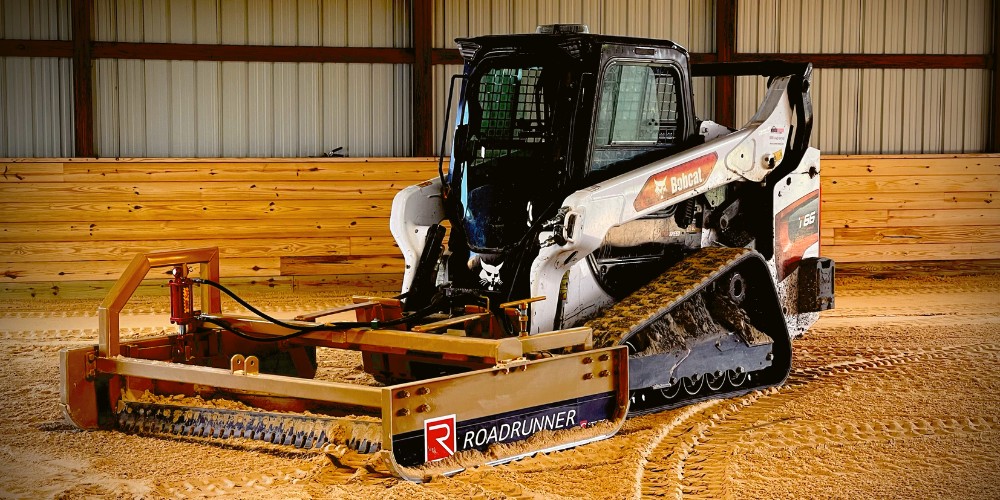A horse’s stride is powerful—but fragile. Each hoof strike sends hundreds of pounds of force into the ground. On an uneven or compacted surface, that impact bounces back through bone and tendon, leading to soreness or even injury.
At Roadrunner Equipment, we build skid steer and tractor grader attachments designed for precision, control, and durability—tools trusted by farmers, ranchers, and equestrian facility owners across the country. Over the years, we’ve seen firsthand how regular grading transforms not only the look of an arena but also the long-term health and performance of the horses who train there.
That’s why grading your equestrian arenas, training tracks, and riding paths isn’t just about appearance—it’s about protecting your horses and extending the life of your facility.
Whether you manage a large boarding stable or ride with your own small herd at home, our graders help keep every surface safe, smooth, and consistent.
Don’t Have Time to Read? Here’s a Summary
Grading your equestrian arenas, training tracks, and riding paths isn’t about looks—it’s about protecting your horses’ health. Each hoof strike delivers hundreds of pounds of force, and uneven footing sends that impact back through the horse’s legs and joints.
Why It Matters:
A properly graded surface cushions movement, reduces strain, and keeps horses safe and comfortable. Most arenas have a firm base and a soft top layer; when the top becomes rutted or compacted, it exposes the base and increases the risk of injury.
Benefits of Regular Grading:
-
Protects Foot Health: Reduces impact on joints and prevents costly injuries.
-
Controls Dust: Mixing water and salt binds materials, improving air quality.
-
Preserves the Base Layer: Prevents ruts and uneven wear that damage footing.
Maintenance Tips:
Grade daily—especially before riding—and alternate your grading patterns. Always grade slightly damp footing for best results.
Roadrunner Equipment skid steer and tractor grader attachments make it easy, cutting high spots and filling low ones in a single pass for smooth, consistent footing every time. A well-graded arena keeps horses performing their best all year.
What Makes a Good Equestrian Riding Surface
No matter the discipline—jumping, galloping, or casual riding—the surface your horse trains on should provide traction, cushioning, and consistency.
Most arenas are built with two layers:
- A firm base layer (about six inches deep) for stability.
- A softer top layer (around three inches deep) for comfort and flexibility.
Over time, hoof impact can displace the top layer, forming ruts and divots. When that happens, horses must work harder to maintain balance, increasing the risk of joint strain.
Traditional dirt-and-sand footing works well, but modern synthetic blends—like recycled rubber or fiber—are growing in popularity. Regardless of material, the key is keeping it evenly distributed with regular grading.
3 Ways Proper Grading Protects Horses and Riders
1. It Protects Foot Health
Horses are strong yet delicate. Their small hooves bear immense pressure, so footing matters. A properly graded surface cushions each step, reduces jarring impact, and keeps the horse’s legs and joints healthy—saving you from unnecessary vet bills down the road.
2. It Keeps Dust at Bay
Dust isn’t just unpleasant—it’s harmful. It can cause eye irritation and respiratory problems for both horse and rider. Mixing water and salt into the top layer while grading helps bind the material, keeping dust under control and improving air quality inside arenas.
3. It Preserves the Base Layer
Once your soft top layer starts to break down, the base layer becomes exposed to damage. When that happens, repairs get costly fast. Consistent grading keeps the footing evenly distributed and prevents deep ruts that compromise the integrity of your base.
How to Tell Your Arena Needs Grading
You’ll know it’s time to grade when you see or feel:
-
Divots or compacted areas from frequent riding
-
Excessive dust clouds during activity
-
Uneven footing or visible base material
If your arena feels harder than usual or water begins to pool, your surface likely needs attention.
Pro Tip: Grade after watering—not before. Slightly damp footing levels more evenly and keeps dust down.
How Often Should You Grade Your Arena or Riding Path?
For optimal safety and performance, grade daily—ideally before your horses start their day. Even small private arenas benefit from consistent maintenance.
Alternate your grading pattern each week to avoid compacting the same tracks, especially in high-traffic areas like corners or jump zones.
The Best Equipment for Grading Horse Arenas and Tracks
Your grading equipment can make or break your arena’s surface quality.
That’s why we build skid steer and tractor grader attachments that make the job simple. Our dual-blade design cuts high spots and fills low ones in a single pass—keeping your top layer even without disturbing the base.
You can adjust blade depth and angle for your specific footing, and our heavy-duty construction means these attachments perform flawlessly on arena sand, dirt tracks, and riding trails alike.
Maintenance Insight: Keep your blades sharp and your grader clean—especially after working with sand or clay footing—to ensure consistent performance.
Common Grading Mistakes to Avoid
Even experienced riders can overlook these simple but costly mistakes:
-
Grading dry footing (creates dust and uneven leveling)
-
Removing too much top material in one pass
-
Ignoring deep hoof prints or divots for too long
-
Using the wrong blade angle or depth setting for your surface type
A little consistency goes a long way—routine maintenance prevents these issues before they start.
Keep Your Horses Safe and Comfortable Year-Round
A properly graded arena isn’t just about aesthetics—it’s a key part of caring for your horses. Smooth, even footing means fewer injuries, cleaner air, and better overall performance.
Whether you’re maintaining a home riding ring or a professional training track, our graders deliver the durability and control you need to get the job done right.
Ready to simplify arena maintenance?
Explore our grader attachments and see how we can help you keep your equestrian facility in peak condition.

